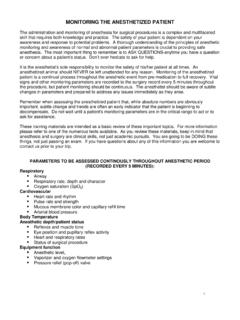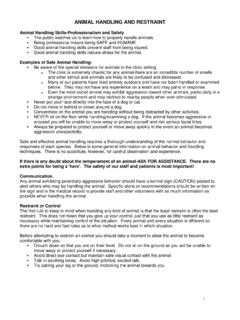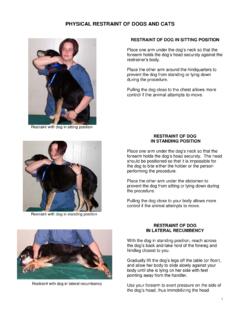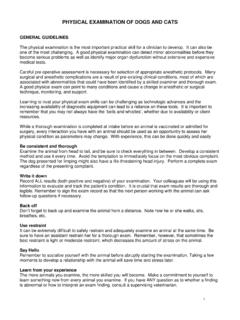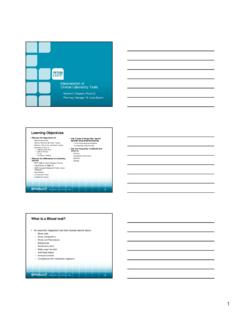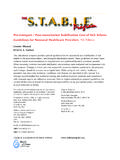Transcription of PHYSICAL EXAMINATION OF DOGS AND CATS
1 1 PHYSICAL EXAMINATION OF DOGS AND CATS GENERAL GUIDELINES The PHYSICAL EXAMINATION is the most important practical skill for a clinician to develop. It can also be one of the most challenging. A good PHYSICAL EXAMINATION can detect minor abnormalities before they become serious problems as well as identify major organ dysfunction without extensive and expensive medical tests. Careful pre-operative assessment is necessary for selection of appropriate anesthetic protocols. Many surgical and anesthetic complications are a result of pre-existing clinical conditions, most of which are associated with abnormalities that could have been identified by a skilled examiner and thorough exam.
2 A good PHYSICAL exam can point to many conditions and cause a change in anesthetic or surgical technique, monitoring, and support. Learning to trust your PHYSICAL exam skills can be challenging as technologic advances and the increasing availability of diagnostic equipment can lead to a reliance on these tools. It is important to remember that you may not always have the bells and whistles , whether due to availability or client resources. While a thorough EXAMINATION is completed at intake before an animal is vaccinated or admitted for surgery, every interaction you have with an animal should be used as an opportunity to assess her PHYSICAL condition as parameters may change.
3 With experience, this can be done quickly and easily Be consistent and thorough Examine the animal from head to tail, and be sure to check everything in between. Develop a consistent method and use it every time. Avoid the temptation to immediately focus on the most obvious complaint. The dog presented for limping might also have a life-threatening head injury. Perform a complete exam regardless of the presenting complaint. Write it down Record ALL results (both positive and negative) of your EXAMINATION . Your colleagues will be using this information to evaluate and track the patient s condition.
4 It is crucial that exam results are thorough and legible. Remember to sign the exam record so that the next person working with the animal can ask follow-up questions if necessary. Back off Don t forget to back up and examine the animal from a distance. Note how he or she walks, sits, breathes, etc. Use restraint It can be extremely difficult to safely restrain and adequately examine an animal at the same time. Be sure to have an assistant restrain her for a thorough exam. Remember, however, that sometimes the best restraint is light or moderate restraint, which decreases the amount of stress on the animal.
5 Say Hello Remember to socialize yourself with the animal before abruptly starting the EXAMINATION . Taking a few moments to develop a relationship with the animal will save time and stress later. Learn from your experience The more animals you examine, the more skilled you will become. Make a commitment to yourself to learn something new from every animal you examine. If you have ANY question as to whether a finding is abnormal or how to interpret an exam finding, consult a supervising veterinarian. 2 PHYSICAL EXAM ALERTS When examining potential surgery patients, keep in mind that you are not only determining their general condition, but evaluating them for anesthetic and surgical risk factors as well.
6 ANY PHYSICAL exam finding that might impact anesthesia or surgery MUST be evaluated by a designated veterinarian or lead technician BEFORE the animal is admitted for surgery so that any potential risks can be discussed with the client before the animal is admitted. HSVMA-RAVS staff always reserve the right to decline surgery on any animal if we believe that there may be risk factors that can not be adequately evaluated. Findings that require a designated supervisor s evaluation include: Any animal with TPR values outside the normal range Any animal older than 6 years of age or younger than 12 weeks of age Any animal weighing less than 5 lbs or more than 75 lbs Any animal with a history of diarrhea or vomiting Any animal with a history of recent trauma (past month) Any animal with significant abnormalities on PHYSICAL exam (dehydration, heart murmur, upper respiratory infection, etc) Abnormalities or findings that might impact anesthesia or surgery ( age, PHYSICAL condition, reproductive status (in heat, pregnant), etc)
7 Should be noted in the Alerts area of the Anesthesia Record and on the Surgery Board to alert the anesthesia team to the findings. PHYSICAL EXAM PROCESS 1) Signalment / History 2) General Appearance / Initial Observations 3) Vital Signs 4) PHYSICAL Exam (Systems Approach or Head to Toe) 5) Surgical / Anesthetic Risk Assessment 6) RAVS Animal Condition (RAC) Score Signalment Complete description of the animal Species, Breed, Age, Sex, Reproductive status, other distinguishing characteristics Always double-check client reported information (sex, age, etc) Keep this information in mind as you examine the animal and make clinical judgments.
8 History (Hx)- (see Patient History Form) Includes environment, diet, medical history, reproductive history, vaccination status and current medications. Description and history of chief/presenting complaint Reported concerns should be followed up with additional questions to clarify nature of the complaint Important note on patient histories Many of the animals that we treat in the field will be presented by caretakers who do not have extensive information on the animal s background or even daily observations. The animal may live outdoors or roam free much of the time, preventing the caretaker from making close observations.
9 In order to obtain a useful history, it is important to phrase questions in such a way as to obtain the most accurate information possible. Asking, Has the animal had diarrhea? may prompt the client to answer No , as they have not observed the animal to have diarrhea. Instead, asking Have you seen the animal s stool recently? will allow you to determine whether the client can provide an accurate description, or whether you may need to look to other PHYSICAL signs for the information. 3 GENERAL APPEARANCE / INITIAL OBSERVATIONS (GA) General appearance observe animal from a distance and up close before any handling Symmetry - note any asymmetry.
10 Note any difference in size or shape of extremities Body condition / State of nutrition (see Purina Small Animal Body Condition Scoring chart) Assign appropriate Body Condition Score using standard nine point scale (BCS = 1-9) In general, the animal is too thin of his ribs are easily seen, normal if they are readily felt without a layer of fat lying over them and obese if it is difficult to feel them at all Mentation / Level of consciousness attentiveness / reaction to environment Alert and responsive Depressed Uncontrolled hyper-excitability Stupor Coma : Normal healthy animal's mentation is often bright, alert and responsive or "BAR".


